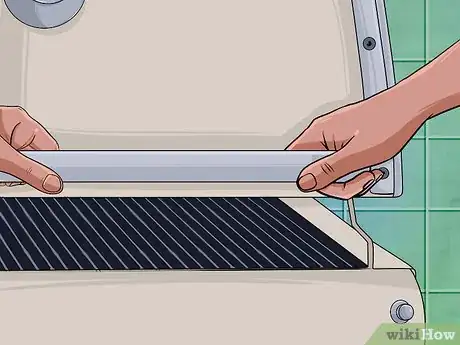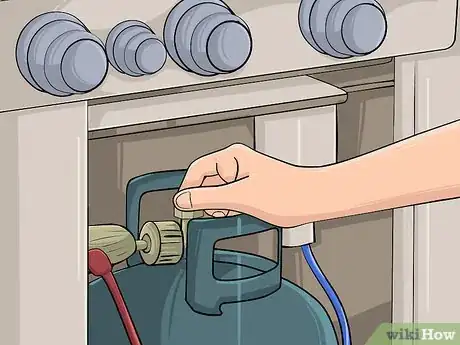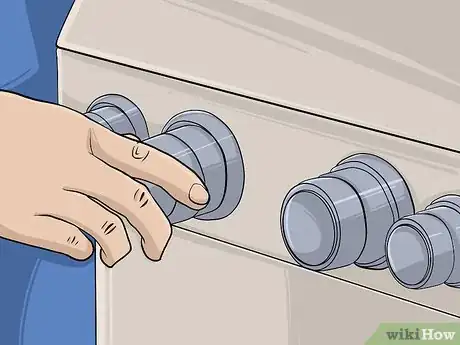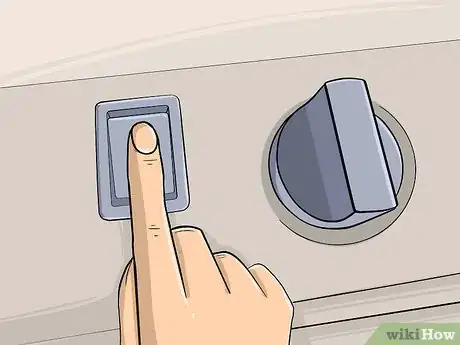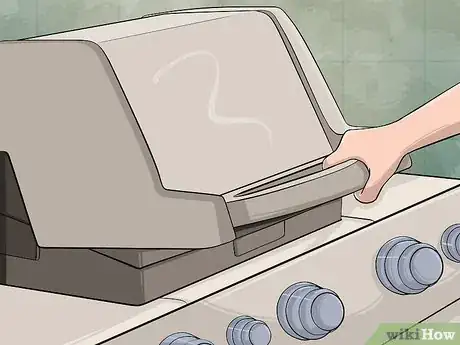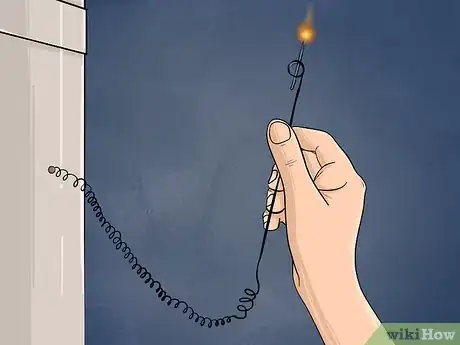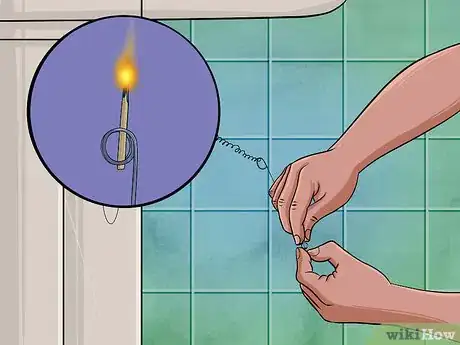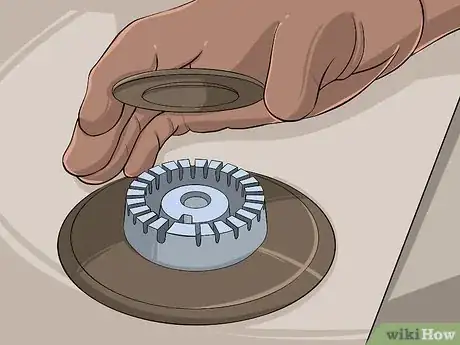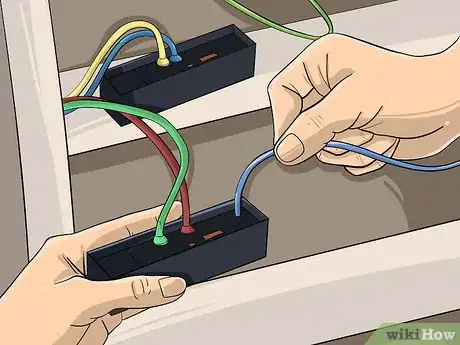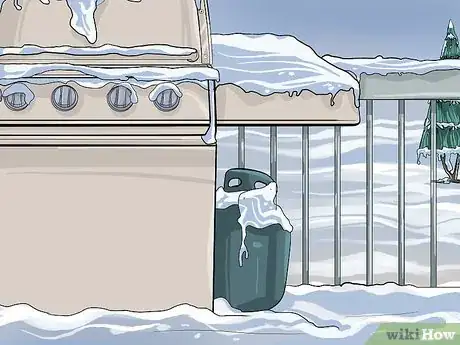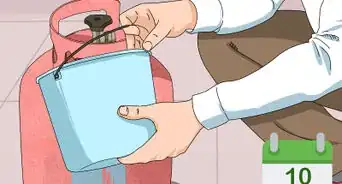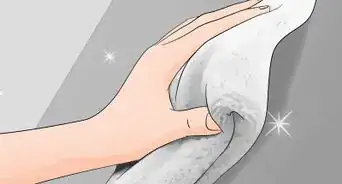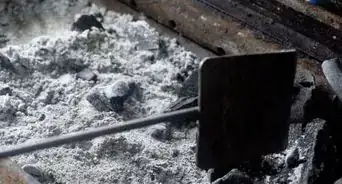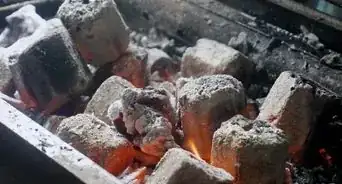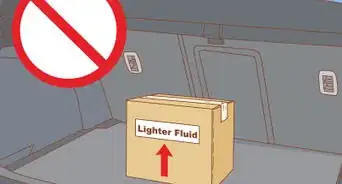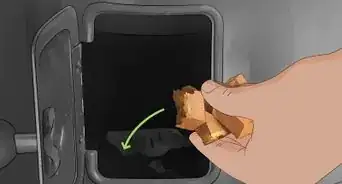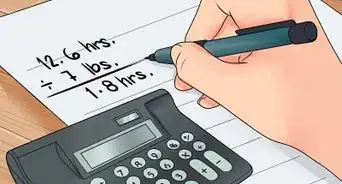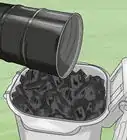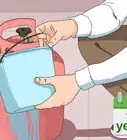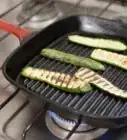This article was co-authored by wikiHow Staff. Our trained team of editors and researchers validate articles for accuracy and comprehensiveness. wikiHow's Content Management Team carefully monitors the work from our editorial staff to ensure that each article is backed by trusted research and meets our high quality standards.
There are 8 references cited in this article, which can be found at the bottom of the page.
This article has been viewed 123,580 times.
Learn more...
Although gas grills are relatively simple in design, if you’re inexperienced with grilling you may be at a loss for how to start one. Many gas grills come with a push-button ignition system. Older or basic models will have to be lit manually. Should your grill fail to light with its automatic starter or manual lighting techniques, troubleshoot your grill by checking lines and valves to resolve the problem.
Steps
Using an Automatic Starter
-
1Open the lid of your grill. Keeping your lid closed while lighting can cause gas fumes to build up. This can create an exploding hazard. If the gas has been turned on with the lid closed, turn off the gas and open the lid. Wait a few minutes for the gas to dissipate, then start the process over.[1]
-
2Hook up gas to your grill, if necessary. In most cases, a propane tank is used to supply your grill with gas. Propane tanks are usually stored beneath, behind, or to the side of the grill. Attach the gas line firmly to the propane tank and the gas intake for your grill.[2]
- Depending on your grill, the hookup for your gas may vary. When in doubt, follow the usage instructions. If you don’t have these, look up a digital manual with a keyword search for your grill online.
- Some grills may be connected by a direct line to the natural gas supplied to your home. This kind of gas supply acts the same as a tank, but is stationary.
- Smaller tabletop grills oftentimes have small canisters of gas which are screwed into the valve of the grill before it can be ignited.
Advertisement -
3Turn on the gas. This is usually done by turning a circular shaped valve on top of the propane tank. Some grills may have a secondary valve on the grill that you need to open for it to receive gas. Open the valve fully, then wait about a minute for the gas to move through the line to the grill.[3]
-
4Ignite the grill. Generally, this involves turning a regulator knob on the front of your grill for the burner closest to the igniter to its highest setting. This will allow gas to flow through the grill up through the grate. Press the igniter button to cause a spark inside the grill and light the gas. Follow the ignition instructions for your grill for the best results.[4]
- Different grills may have different designs, like ones that have the starter and regulator knob combined. Follow the grill instructions when confused about the ignition procedure.
- Once one burner is lit, you can light burners next to the lit one without the igniter by simply turning on the regulator knobs for these burners.
Starting a Gas Grill Manually
-
1Open the lid of your grill and hook up its gas, if necessary. With the lid closed, potentially dangerous explosive gas won’t have a chance to build up. Hook up your gas by attaching the gas line to the gas output, like a tank, and the input, like a connector on the back or side of the grill.
- Gas inputs and outputs are usually preceded or followed by a shutoff valve and are frequently shaped like spigots.[5]
-
2Open the valve for the gas supply. On the connector that’s linking your gas supply to your grill there should be a shutoff valve. Open this fully to supply gas to your grill. Wait a few minutes after opening the valve to give the gas enough time to fill the line.[6]
-
3Turn on and ignite the gas. Place a match in the lighting hole. This should be a small hole located on the grill’s side. Open the regulator for the burner closest to the lighting hole fully. Light the first match already in the lighting hole with a second match. The turned on burner should light.
- After your first burner lights, it’s a simple matter to turn on the regulator knobs for the other burners. They should light off the flame already burning in your grill.
- Some models of grill may not have lighting holes or might have poorly designed ones. In this case, stand as far from the grill as you can and use a long stick match to light the grill.[7]
Troubleshooting Your Grill
-
1Check the gas supply and supply lines. If your tank is empty or your gas supply line is turned off, even a perfectly functioning grill won’t work. Replace empty tanks. Turn all supply valves to the "On" position once the gas supply and grill are hooked up. Check supply lines for cracking, looseness, and other signs of wear and tear. Replace old or faulty supply lines.[8]
- If the rubber of your supply line feels brittle, it’s a good sign the line should be replaced. Replacement parts can be found at most hardware stores and home centers.
- When the grill and gas supply are properly hooked up and the gas turned on, a hissing sound, especially from connectors or valves, could be a sign of a gas leak. Leaks can result in fire or explosions. Turn off the gas and stop using your grill immediately if you suspect a leak.
-
2Use a manual method of lighting for faulty starters. The starter on your grill is used every time you fire it up. The frequent usage of this part sometimes causes it to break or fail. When you’re certain you have gas and the supply lines are in good condition, manual lighting is a great solution for faulty starters.[9]
- Sometimes you can tell when an igniter is bad by the sound it makes. If you push your igniter and it makes a different sound than normal, this could indicate that your igniter no longer works.
-
3Replace burners, when necessary. If your gas supply is fine and the igniter seems to be working, the problem may be with the burners under the grate of your grill. Follow your grill instructions for proper replacement procedures.[10]
- Before replacing your burner, try resetting its regulator. This may not be possible for all grills, but if it is for yours, instructions on how to do this will be in the grill's manual.
- You can usually replace burners inexpensively with a suitable new part purchased from a hardware store, home center, or the manufacturer.
-
4Inspect electrical components, if applicable. Many newer grills have batteries and electrical lines to supply power to other functions of the grill. These can come loose or degrade over time. Re-fasten loose electrical cables. Replace any batteries that might be flat, then try to light your grill again.
- Igniters, in some cases, use a small battery to power the ignition mechanism. The placement of this part will depend on your grill, but many times it is situated close to or underneath the igniter switch.[11]
-
5Allow more time for cold tanks to supply gas to the grill. Cold weather can cause the internal pressure of tanks to decrease. This can cause the gas to flow slower than normal or freeze. Allow additional time for gas to feed through the supply line to your grill when it is chilly or cold.
- If your tank has frozen, you won’t be able to use it until it has thawed. Bring the tank in a warmed location, like a shed or basement, so it can thaw.
Warnings
- Even with proper usage, grilling poses a fire hazard. Have a bucket of water or a functional hose nearby to douse any accidental fires.⧼thumbs_response⧽
Things You'll Need
- Gas
- Grill
- Matches (optional)
References
- ↑ https://www.charbroil.com/community/light-gas-grill-manually/
- ↑ http://www.weber.com/weber-nation/grill-skills/mastering-basics/gas-1/lighting-a-gas-grill
- ↑ http://www.weber.com/weber-nation/grill-skills/mastering-basics/gas-1/lighting-a-gas-grill
- ↑ http://www.cookincanuck.com/2011/06/how-to-turn-on-a-gas-grill-barbecue-101/
- ↑ http://www.cookincanuck.com/2011/06/how-to-turn-on-a-gas-grill-barbecue-101/
- ↑ http://www.weber.com/weber-nation/grill-skills/mastering-basics/gas-1/lighting-a-gas-grill
- ↑ https://www.charbroil.com/community/light-gas-grill-manually/
- ↑ http://www.searspartsdirect.com/article/easy-diy-gas-grill-repairs-if-the-burner-wont-light.html
- ↑ https://www.charbroil.com/help/gas/
About This Article
To start a gas grill, first open the lid and make sure your gas canister is hooked up. Open the valve on top of the cannister and wait a few minutes for the gas to fill the line. If your grill has a separate valve, turn this on too. Once you’ve turned the gas on, ignite the grill by pressing the igniter button. If your grill needs to be lit manually, place an unlit match in the lighting hole on the side. Open the regulator for the burner closest to the lighting hole. Then, light the first match with a second one. This should light the burner. For more tips, including how to troubleshoot problems with your grill, read on!
